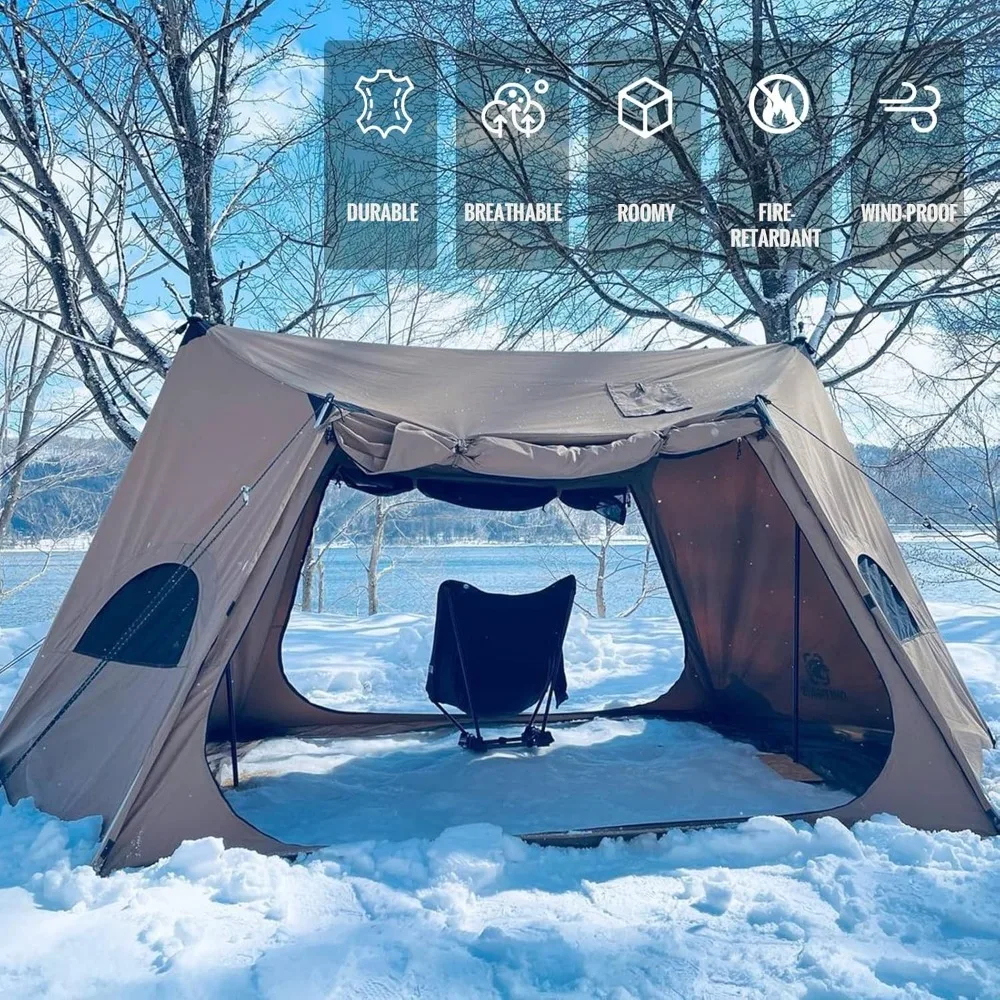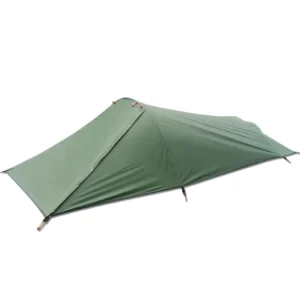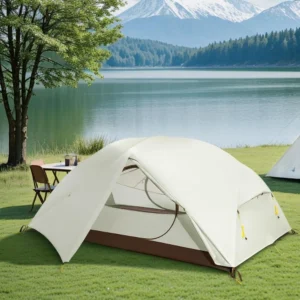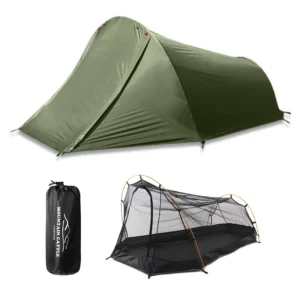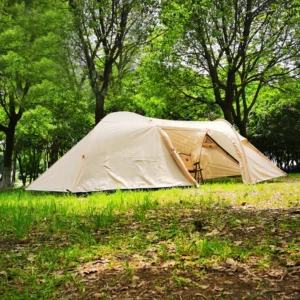Introduction: Choosing the Right Tent Material for Wilderness Camping
When planning a wilderness adventure, few decisions impact your comfort, safety, and overall experience as much as your choice of tent material. The fabric that forms your shelter’s walls can mean the difference between a peaceful night under the stars and a long, miserable experience battling the elements.
Canvas and nylon represent the two primary tent material options available to outdoor enthusiasts today, each with distinct advantages and limitations depending on your specific wilderness needs:
- Weather protection capabilities across rain, snow, and wind conditions
- Temperature regulation during hot days and cold nights
- Durability against rough terrain and extended use
- Weight considerations for transportation to your campsite
This comprehensive guide will help you navigate the canvas vs nylon decision, drawing on Explore Elements’ extensive experience testing tents across extreme conditions from desert heat to mountain snowstorms. By understanding the unique properties of each material, you’ll be equipped to select the perfect tent for your next wilderness expedition.
The right tent material choice becomes particularly crucial when facing challenging conditions like torrential rain, high alpine winds, or temperature extremes where rugged camping shelters designed for canvas might offer significant advantages.
Understanding Tent Materials: Canvas vs Nylon Basics
Before diving into specific performance aspects, let’s establish a clear understanding of what distinguishes these two popular tent materials.
Canvas traditionally consists of tightly woven cotton fibers, though modern versions often incorporate poly-cotton blends to enhance performance while reducing some of traditional canvas’s drawbacks. The natural fibers create a dense, breathable fabric with substantial weight and texture.
Nylon tents utilize synthetic polymers, commonly appearing as ripstop nylon (featuring a reinforced crosshatch pattern to prevent tears), silnylon (silicone-impregnated for enhanced waterproofing), or polyester blends for improved UV resistance. These materials create an extremely lightweight, thin fabric that packs down remarkably small.
| Feature | Canvas | Nylon |
|---|---|---|
| Material Composition | Cotton or poly-cotton blend (natural fibers) | Synthetic polymer (man-made) |
| Weight (4-person tent) | 40-80 lbs (18-36 kg) | 5-12 lbs (2.3-5.4 kg) |
| Typical Applications | Base camps, hunting, winter expeditions | Backpacking, mountaineering, lightweight camping |
| Price Range | $300-$2,000+ | $100-$800+ |
| General Durability | Exceptional against abrasion, moderate UV resistance | Moderate abrasion resistance, poor UV durability |
| Weather Performance | Excellent in cold, good in wet conditions (when treated) | Excellent in wet conditions, variable in extreme temperatures |
Understanding the fundamental differences between these materials provides essential context for evaluating their performance characteristics. The definitive guide to heavy-duty canvas shelters offers more detailed information about canvas construction techniques and material variations.
Durability and Longevity in Wilderness Conditions
When exploring remote wilderness areas, your tent’s ability to withstand environmental challenges becomes paramount. The durability difference between canvas and nylon represents one of the most significant factors in the decision-making process.
Canvas Durability Advantages:
* Exceptional resistance to punctures and tears from branches, rocks, and general campsite hazards
* Superior resistance to abrasion damage when brushing against rough surfaces
* Ability to withstand significant tension without structural failure
* Easy field repairs using simple sewing techniques or patch kits
* Potential lifespan measured in decades with proper maintenance
* Natural UV resistance that far exceeds synthetic materials
Nylon Durability Considerations:
* Lighter weight corresponds to reduced puncture and tear resistance
* Denier rating (fabric thickness measurement) significantly impacts durability; higher numbers indicate stronger material
* Ripstop construction provides fail-safes that prevent small tears from expanding
* Progressive UV degradation remains an unavoidable weakness, particularly with prolonged sun exposure
* Typical lifespan ranges from 5-10 years with regular use, declining faster in harsh conditions
* Field repairs tend to be temporary solutions rather than permanent fixes
Environmental conditions dramatically impact durability considerations. Rocky alpine terrain, thorny desert vegetation, and frequent wildlife encounters all pose greater challenges for nylon’s thinner construction. However, canvas tents perform exceptionally well in rough weather and challenging physical environments where durability becomes the priority.
Weather Performance: Rain, Wind, and Snow Protection
Your tent’s ability to protect against precipitation, wind, and snow load often determines your comfort level and sometimes even safety in wilderness settings.
Rain Protection:
* Canvas naturally swells when wet, creating a tight weave that prevents water penetration once the initial “weathering” process occurs
* Traditional canvas requires proper weathering before achieving maximum waterproofness
* Modern canvas often features factory waterproof treatments that enhance performance
* Nylon relies entirely on waterproof coatings (polyurethane or silicone) for water resistance
* Nylon coatings gradually degrade with use and UV exposure, requiring periodic reapplication
* Hydrostatic head ratings (water pressure resistance) typically start higher on nylon but maintain longer on canvas
Wind Resistance:
* Canvas weight provides natural stability in high winds when properly secured
* Canvas absorbs and dampens wind energy rather than reflecting it
* Nylon’s flexibility allows it to bend without breaking in strong gusts
* Modern nylon tent designs often incorporate aerodynamic shapes that shed wind effectively
* Both materials require proper staking and guy lines for optimal wind performance
* Pole structure quality often matters more than fabric type for ultimate wind stability
Snow Load Capacity:
* Canvas excels under snow load due to natural strength and minimal stretch
* Many canvas designs accommodate wood stoves, ideal for winter camping
* Specialized four-season tents built for durability typically feature reinforced poles regardless of material
* Nylon designs require steeper angles and stronger frames to prevent collapse under snow accumulation
* Alpine expeditions often utilize specialized nylon tents with exceptional pole structures
For serious weather protection in extended wilderness stays, canvas camping tents provide remarkable resilience against combined environmental challenges.
Temperature Regulation and Comfort
A comfortable wilderness shelter needs to do more than just block rain—it must help regulate interior temperature and manage moisture to create a livable environment.
Insulation Properties:
* Canvas provides natural insulation through thicker material construction
* Cotton fibers trap air, creating a barrier against outside temperatures
* Canvas walls dampen temperature fluctuations between day and night
* Nylon offers minimal insulation value due to thin construction
* Nylon tents require more supplemental insulation (sleeping bags, pads) in cold conditions
* Temperature differences between identical canvas and nylon tents can reach 10-15°F (5-8°C) in cold weather
Breathability and Condensation Control:
* Canvas naturally allows microscopic water vapor to escape while blocking rain
* Cotton’s porous structure promotes air exchange, significantly reducing condensation
* Nylon’s waterproof coatings prevent both water entry AND vapor escape
* Condensation management in nylon tents relies almost entirely on ventilation design
* Morning condensation in nylon tents commonly results in interior “rain” when touched
* Insulated canvas shelters for cold weather camping demonstrate superior moisture management
Wood Stove Compatibility:
* Many canvas tents accommodate stove jacks for safe wood stove installation
* The natural fibers can withstand proximity to higher heat sources
* Nylon melts when exposed to sparks or high heat, making stove use dangerous or impossible
* For extreme cold environments, this difference alone may determine material choice
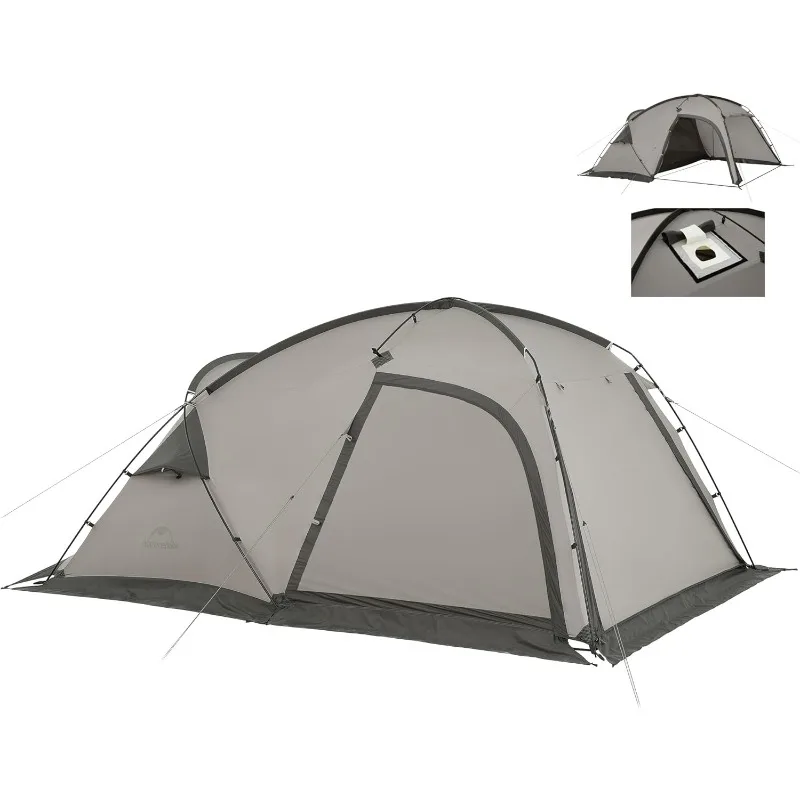
For temperature extremes, particularly cold weather expeditions, winter camping tents with proper insulation features become essential for comfort and safety.
Weight and Portability Considerations for Wilderness Travel
Perhaps the most dramatic difference between canvas and nylon tents comes down to their weight and transportation requirements—a factor that can entirely determine their suitability for certain wilderness adventures.
| Tent Type | Typical Weight | Packed Size | Transportation Method |
|---|---|---|---|
| 4-person Canvas Wall Tent | 50-70 lbs (23-32 kg) | 30”×15”×10” | Vehicle, boat, horse, sled |
| 10×12 Canvas Outfitter Tent | 70-100+ lbs (32-45+ kg) | 40”×20”×15” | Vehicle required |
| 4-person Nylon Backpacking Tent | 5-8 lbs (2.3-3.6 kg) | 18”×7” | Backpack |
| 4-person Ultralight Nylon Tent | 3-5 lbs (1.4-2.3 kg) | 16”×6” | Backpack |
Canvas Transportation Requirements:
* Virtually always requires vehicle transport to trailhead
* Often necessitates multiple trips or multiple carriers for wilderness setup
* Creates significant weight burden even when distributed among group members
* Limits access to remote locations requiring long approaches
Nylon Portability Advantages:
* Makes solo wilderness travel realistic and comfortable
* Enables multi-day backcountry exploration with reasonable pack weights
* Compresses to minimal size within a backpack
* Allows access to remote wilderness locations far from roads
For wilderness adventures requiring mobility, lightweight backpacking tents constructed from nylon and modern synthetics provide accessibility to remote locations that would be impractical with canvas.
Setup and Takedown in Wilderness Environments
After a long day of wilderness travel, your tent setup experience significantly impacts overall satisfaction. The material difference between canvas and nylon substantially affects this process.
Canvas Setup Considerations:
* Typically requires 15-45 minutes for complete setup
* Often necessitates two or more people for efficient installation
* Involves heavy poles, numerous stakes, and multiple guy lines
* Requires careful tension adjustment to prevent sagging
* Demands significant physical effort, especially challenging after exhausting travel
Nylon Setup Advantages:
* Modern designs often set up in 5-10 minutes
* Frequently manageable by a single person
* Features lightweight aluminum or composite pole systems
* Utilizes color-coding and intuitive designs for simple assembly
* Requires less physical exertion, welcome after strenuous hiking
Adverse conditions further amplify these differences. Setting up a canvas tent in rain, high winds, or darkness compounds the challenge considerably, while many nylon tents can be quickly deployed even in difficult circumstances.
The comprehensive canvas tent setup guide with expert tips provides techniques to streamline the process, though the inherent complexity remains compared to modern nylon alternatives.

For those prioritizing quick campsite establishment, easy setup camping tents offer significant advantages, especially when changing locations frequently during wilderness travel.
Maintenance and Care for Extended Wilderness Use
Proper maintenance dramatically affects tent longevity, performance, and value—with significant differences between materials.
Canvas Maintenance Requirements:
* Must be completely dry before long-term storage to prevent mold and mildew
* Requires thorough air drying, potentially for several days after wet conditions
* Benefits from periodic retreatment with appropriate waterproofing solutions
* Needs cleaning to remove dirt, sap, and environmental contaminants
* Demands proper storage in dry, well-ventilated conditions between trips
* May require professional cleaning for stubborn issues
Nylon Maintenance Needs:
* Dries quickly, typically within hours rather than days
* Requires regular inspection of seams and potential resealing
* Needs protection from extended UV exposure even during storage
* Benefits from gentle cleaning to remove dirt and oils that can degrade waterproof coatings
* Requires periodic reapplication of water-resistant treatments
* Should be stored fully dry and loosely packed
Field maintenance represents another key difference. Canvas tears can often be permanently repaired in the field with basic sewing skills, while nylon typically requires specialized repair tape for temporary fixes until proper repair at home. The canvas tent care guide provides detailed information on maintaining these shelters for maximum longevity.
For those concerned about waterproofness maintenance, waterproof camping tents offer different approaches to moisture protection depending on material construction.
Cost Analysis: Initial Investment vs. Long-Term Value
The financial consideration extends far beyond the initial purchase price, especially when evaluating the long-term value proposition of these different materials.
| Tent Type | Initial Price Range | Expected Lifespan | Cost Per Year | Maintenance Costs |
|---|---|---|---|---|
| Quality Canvas Tent | $500-$2,000+ | 10-20+ years | $25-$100/year | Moderate ($20-50/year) |
| Quality Nylon Tent | $200-$800 | 3-8 years | $25-$150/year | Low-Moderate ($10-30/year) |
While canvas tents require a substantially higher upfront investment, their extended lifespan often results in comparable or lower cost-per-year of ownership. Additionally, canvas tents typically maintain higher resale value as a percentage of purchase price compared to used nylon tents, which depreciate more rapidly.
Value considerations extend beyond simple cost calculations. The enhanced comfort, durability, and unique experiences offered by each material may justify different price points depending on individual priorities and wilderness activity patterns.
For those seeking maximum long-term value for challenging conditions, heavy-duty 4-season tents provide exceptional durability regardless of material choice, though at premium price points.
Best Applications: Matching Tent Materials to Wilderness Activities
Rather than declaring one material universally superior, experienced outdoors people match tent materials to specific wilderness applications where their strengths shine.
Ideal Canvas Tent Applications:
* Extended base camps where setup occurs once for a prolonged stay
* Cold-weather expeditions requiring wood stove compatibility
* Hunt camps supporting multiple users with equipment
* Family wilderness camping prioritizing space and comfort
* Locations accessible by vehicle, boat, or pack animals
* Scenarios where durability against harsh elements outweighs portability concerns
Ideal Nylon Tent Applications:
* Backpacking journeys covering substantial distance
* Mountaineering expeditions requiring minimal weight
* Solo or small group wilderness travel
* Trips involving frequent location changes
* Situations where every ounce matters due to physical exertion
* Moderate weather conditions where extreme durability is less critical
The appropriate choice often becomes obvious when considering your specific wilderness plans. A week-long backcountry fishing trip with daily location changes strongly favors nylon, while a two-week elk hunting base camp might benefit tremendously from canvas construction.
Lightweight Backpacking Tent, Ultralight Backpacking Tent, Ultralight Bivy Tent
Ultralight Single Person Camping Tent with Aluminum Poles for 3-Season Backpacking Waterproof DesignPrice range: $94.88 through $326.82 Select options This product has multiple variants. The options may be chosen on the product pageLightweight Backpacking Tent, Ultralight Backpacking Tent, Waterproof Backpacking Tent
$391.05 Select options This product has multiple variants. The options may be chosen on the product pageHeavy Duty 4 Season Tent, Mountaineering Tent, Winter Camping Tent
$870.40 Select options This product has multiple variants. The options may be chosen on the product pageCompact Backpacking Tent, Lightweight Backpacking Tent, Waterproof Camping Tent
$335.52 Select options This product has multiple variants. The options may be chosen on the product pageUltralight Backpacking Tent, Ultralight Dome Tent, Winter Camping Tent
Price range: $369.63 through $370.07 Select options This product has multiple variants. The options may be chosen on the product pageCamping Tent with Vestibule, Waterproof Camping Tent
Price range: $407.89 through $479.48 Select options This product has multiple variants. The options may be chosen on the product page
For variable conditions throughout the year, understanding multi-season tents for variable climates helps match materials to changing environmental challenges.

How Does Canvas Compare to Nylon in Extreme Wilderness Conditions?
Heavy Rain and Storms
Canvas maintains structural integrity during extended downpours and often improves waterproofness through fiber swelling. Properly treated canvas can withstand days of continuous rain without leaking. Nylon may sag when wet, requiring frequent adjustment, though initially repels water effectively until coatings wear thin.
Extreme Cold Weather
Canvas provides superior insulation value, particularly when used with internal heat sources like wood stoves. The natural fibers maintain flexibility even in sub-zero temperatures, while nylon becomes increasingly brittle in extreme cold, potentially cracking if folded sharply below 0°F (-18°C).
High Wind Stability
The heavier weight of canvas provides natural stability in high winds, though requires proper tensioning. Modern geodesic nylon designs can withstand remarkable wind forces when properly anchored, sometimes exceeding traditional canvas designs. Understanding what makes tents windproof helps evaluate material performance differently.
Desert/Hot Weather
Canvas breathability creates significantly cooler interiors in hot, dry climates, often measuring 10-15°F cooler than nylon at peak heat. However, nylon with UV-reflective coatings and proper ventilation can create effective sun protection while weighing substantially less.
Humid Environments
Canvas breathability helps manage internal humidity but requires vigilant drying to prevent mold. Nylon’s waterproof coatings prevent external moisture penetration but trap interior humidity, requiring excellent ventilation design to prevent condensation buildup.
Is a Canvas Tent Worth the Extra Weight for Wilderness Camping?
When the Weight Penalty is Justified:
* Extended stays at a single wilderness location minimize the impact of one-time transport effort
* Winter camping scenarios where insulation and stove compatibility provide crucial safety benefits
* Situations where durability against extreme elements outweighs mobility concerns
* Group expeditions where weight can be distributed among multiple carriers
When Lighter Nylon Makes More Sense:
* Solo wilderness travel where individual carrying capacity is limited
* Journeys covering substantial distances between campsites
* Trips requiring frequent elevation gain and loss while carrying gear
* Expeditions where fatigue management impacts safety and enjoyment
Some modern canvas-poly blends offer middle-ground options with moderate weight reduction while maintaining much of traditional canvas’s durability and comfort advantages.
Are There Hybrid Materials That Combine Canvas and Nylon Benefits?
The search for the perfect tent material has led to innovative hybrid approaches that attempt to capture advantages from both traditional categories:
- Polycotton blends incorporate synthetic fibers with natural cotton, reducing weight by 20-30% compared to pure canvas while maintaining much of its breathability
- Treated lightweight canvas employs modern waterproofing technologies that eliminate the traditional weathering process
- Advanced synthetic alternatives like Dyneema (formerly Cuben Fiber) offer exceptional strength-to-weight ratios exceeding both traditional materials, though at premium price points
- Technical cotton combines natural fibers with sophisticated manufacturing techniques to enhance performance while maintaining breathability
While these innovative materials show promise, they typically come with higher price tags and don’t completely eliminate the fundamental tradeoffs between durability and weight.
Decision Guide: Making Your Final Canvas vs. Nylon Choice
When selecting your wilderness tent material, consider these critical questions:
- How will you transport your tent? Vehicle access suggests canvas might be viable, while backpacking strongly favors nylon.
- What’s your typical trip duration? Longer stays at one site justify canvas’s comfort advantages.
- What weather conditions will you typically face? Extreme conditions in either direction (hot/cold) may favor canvas’s regulation properties.
- Is internal heating (wood stove) necessary? This requirement essentially mandates canvas construction.
- What’s your budget for initial purchase vs. long-term ownership? Canvas represents higher upfront cost but potentially better long-term value.
The ideal approach for serious wilderness enthusiasts often involves owning both types—lightweight nylon options for mobile adventures and canvas for base camping scenarios. This complementary approach ensures you have the right tool for each wilderness situation.
Remember that personal preferences regarding comfort, aesthetic experience, and connection to traditional camping methods may outweigh strictly practical considerations for many outdoor enthusiasts. The best tent ultimately remains the one that encourages you to spend more time enjoying wilderness experiences.

